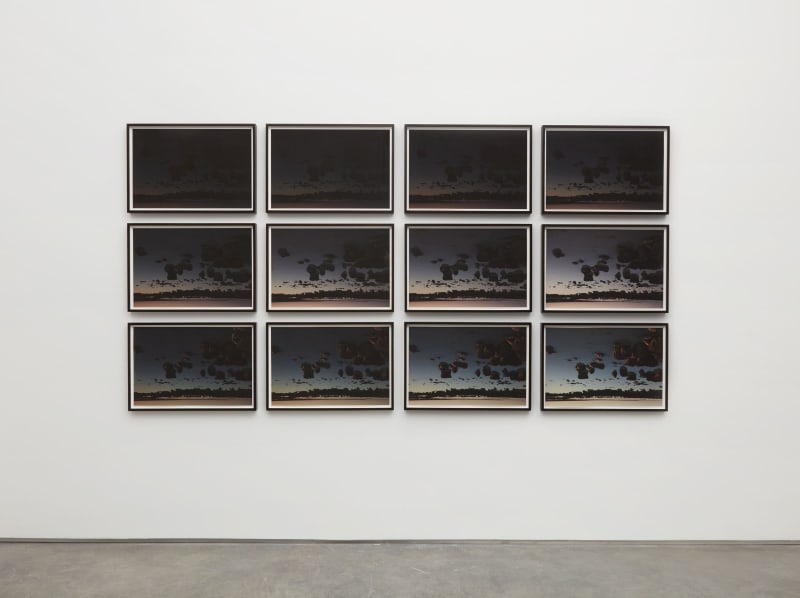INTERVIEW WITH OSMAN CAN YEREBAKAN
The Brazilian artist Thiago Rocha Pitta finds inspiration in mysteries and precision of nature. With its unpredictable transformations and resolute magnitude, the nature is in the core of the artist’s mesmerizing fresco works and tranquil video piece in The First Green. Artspeak editor Osman Can Yerebakan spoke with the artist who is currently in his hometown Sao Paulo.
Osman Can Yerebakan: You seem to let nature be the artist. The nature follows its own evolution and transformation through wind, rain and other occurrences, similar to gestures of painter or sculptor.
Thiago Rocha Pitta: We can not escape from gravity, nor fight against it. We have to go with the flow. I am not taking advantage of the nature, but try to understand how liquids flow and things transform. I believe we should stop putting barriers between ourselves and nature since we are all parts of it. Once, somebody asked me a similar question and I said that the nature coauthors everything we do. When you think about it, we are 70% water. While the life in the ocean has billions of years, the life on land can no way compare to that—water is the source of everything. If you look at nature with a microscope, it’s really interesting. The cells that give leaves colors are cyanobacterias. Listen to the wind and the sound that leaves create. You will hear that they sound like the ocean because it’s wet on the leaves—they are constantly releasing water.
OCY: Earth Day was only a few days ago. The march was even more meaningful this year considering the gaining restraint on scientific thinking. Has your practice been influenced by the latest political climate?
TRP: Jeffrey Marlow of Discover came to the see the exhibition. We both believe that art and science can blend. The scientific narrative of the origin of the world needs to meet the narrative tools of art and artistic methods of expression. Scientists sometimes do not reach the community. I have a six-year old; I tell him stories of Homer and Odysseus, but talk to him about how the atmosphere transformed as well. They are similar cosmic narratives. We should mingle them because they are equally confusing. In scientific speech, I miss a lot and it’s nicer and more effective to read mythology, I believe. Therefore, I think science and mythology can collaborate. Think of Land Art and how artists used landscapes and nature. We don’t have similar iconology anymore. That’s why I think Robert Smithson was a pioneer.
OCY: Fresco is such as ancient technique, yet you revive this method in a conceptual fashion both by introducing a minimal aesthetic and relevant subject matter. How did fresco blend into your practice?
TRP: I always wanted to do frescos; you don’t need glue or binder. It is a very alchemic process and similar to working with bacteria. The process mainly is playing with oxygen. Carbon cycle is the first step. I find the whole process to be very similar to volcanoes. Boiling of liquids, evaporation of water and absorption of carbon from the atmosphere are all in the process. I go to Italy very often, so I was looking into fresco classes there. A friend who makes mosaics gave me the opportunity to experiment. I like the green so I primarily mix blue and yellow; the mix of two colors gives me the color spectrum I like. I do everything horizontally like watercolors. No brush is involved, so I just let the paint float on the surface.
OCY: The Green Shelter sculpture piece in the center has a ghostly presence although it represents a geographical form. You clearly tie a conversation between the body and nature. How does this duality affect your work?
TRP: There is a duality in that sculpture for sure. The sculpture has a rebar iron structure like the bones and skeleton. We dipped the fabric in thick soup-like cement and then there is the fabric which is like skin. Somehow you can’t see it, but there is a lot of dirt under the moss, so the dirt is inside the body. Almost two years ago when they told me the exhibition would be in April, I was already in search of bacteria. The exhibition opened the first day of April which in a way symbolizes the spring; it’s a rebirth that comes every year. In Brazil where I am now on the other hand is fall.
Going back to the sculpture, the fabric on top symbolizes a tension between the weight of cement and the lightness of the soul. I made gravel and mixed it with mud, then we threw this medium, which was between soft and solid, over the structure. When it was very wet, we put the moss. Therefore, chance is an important element here. You don’t know what it will look like. I can say that chance is a very common character of my work.
OCY: Before the Dawn video offers a contemplative and meditative approach to the universe during extreme social and political chaos around the globe. Was this element a part of your vision while working on the video?
TRP: I always think about political landscape, for sure. In Brazil we have a similar atmosphere to dictatorship. That wasn't my initial perspective, but I do think when you study geology and astronomy you realize how insignificant we are as human beings. We are very small but a special part of this crazy scale of the universe. We have to accept that we are not on the top of the picture. Global warming is of course a major issue, but the terrible landscape we live in make global warming a neglected topic. Because so much is happening around the world, we forget to focus on this issue. My political statement is to show how insignificant we are as humans. We belong to nature, we don’t own it.

